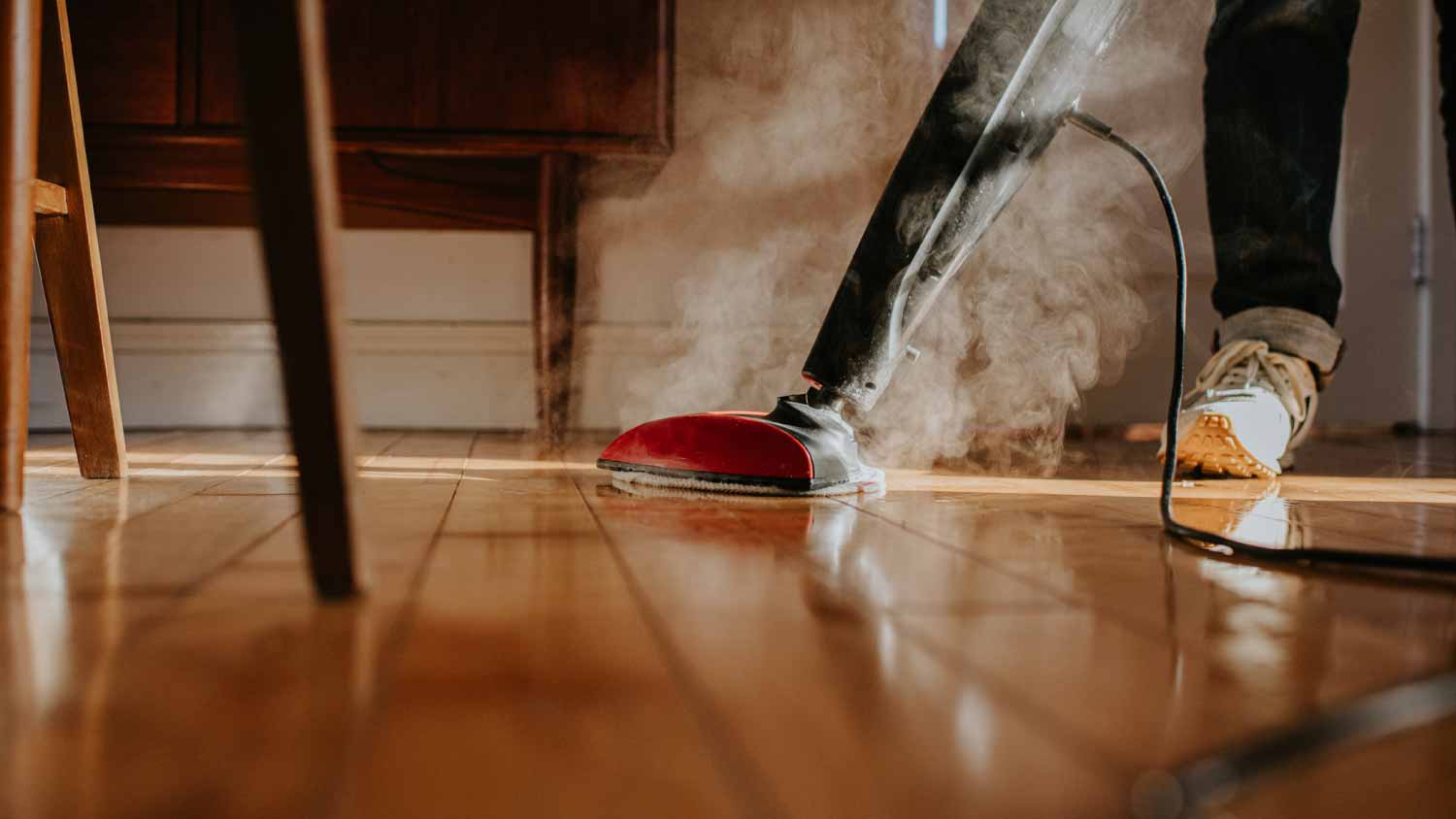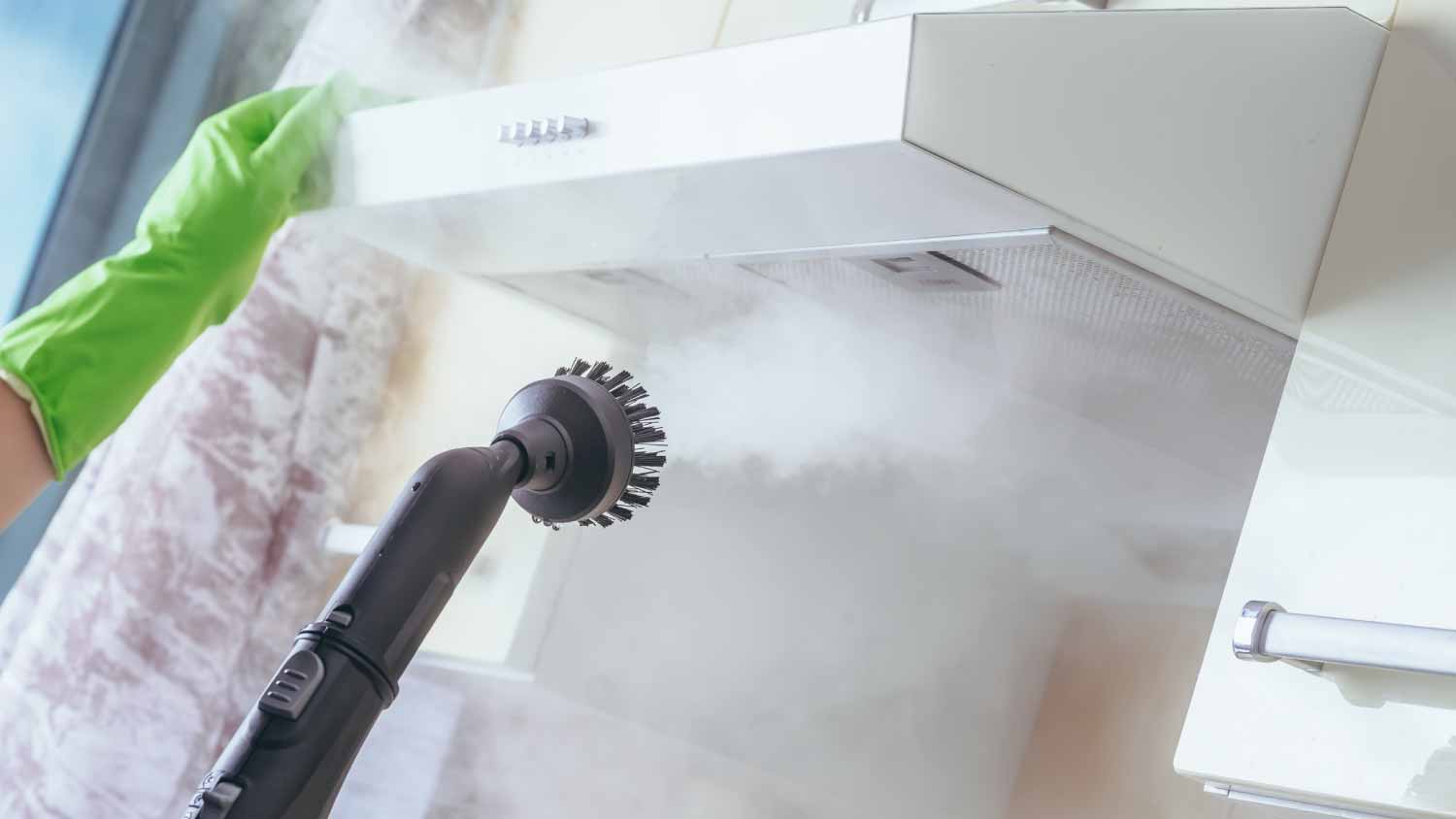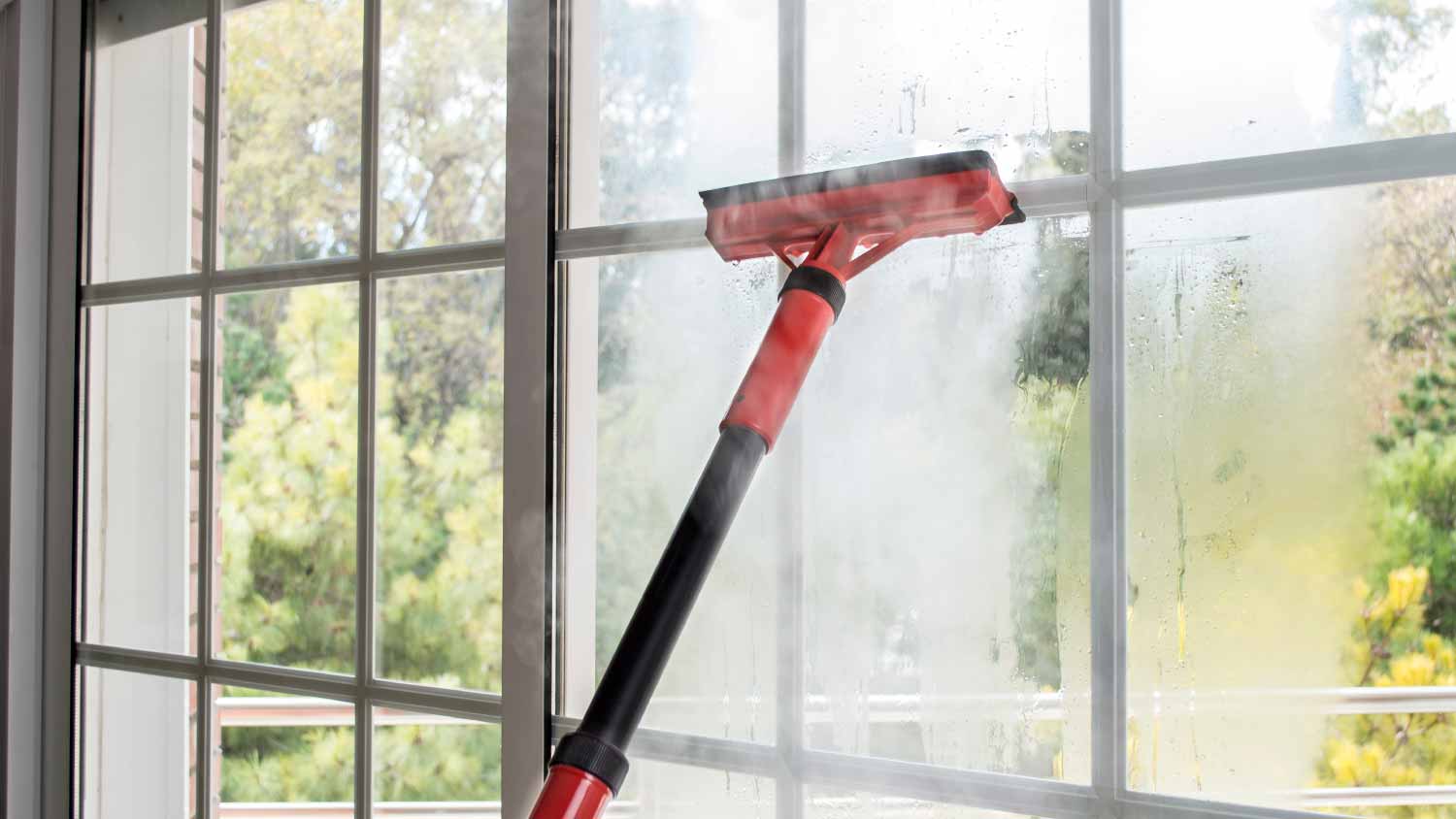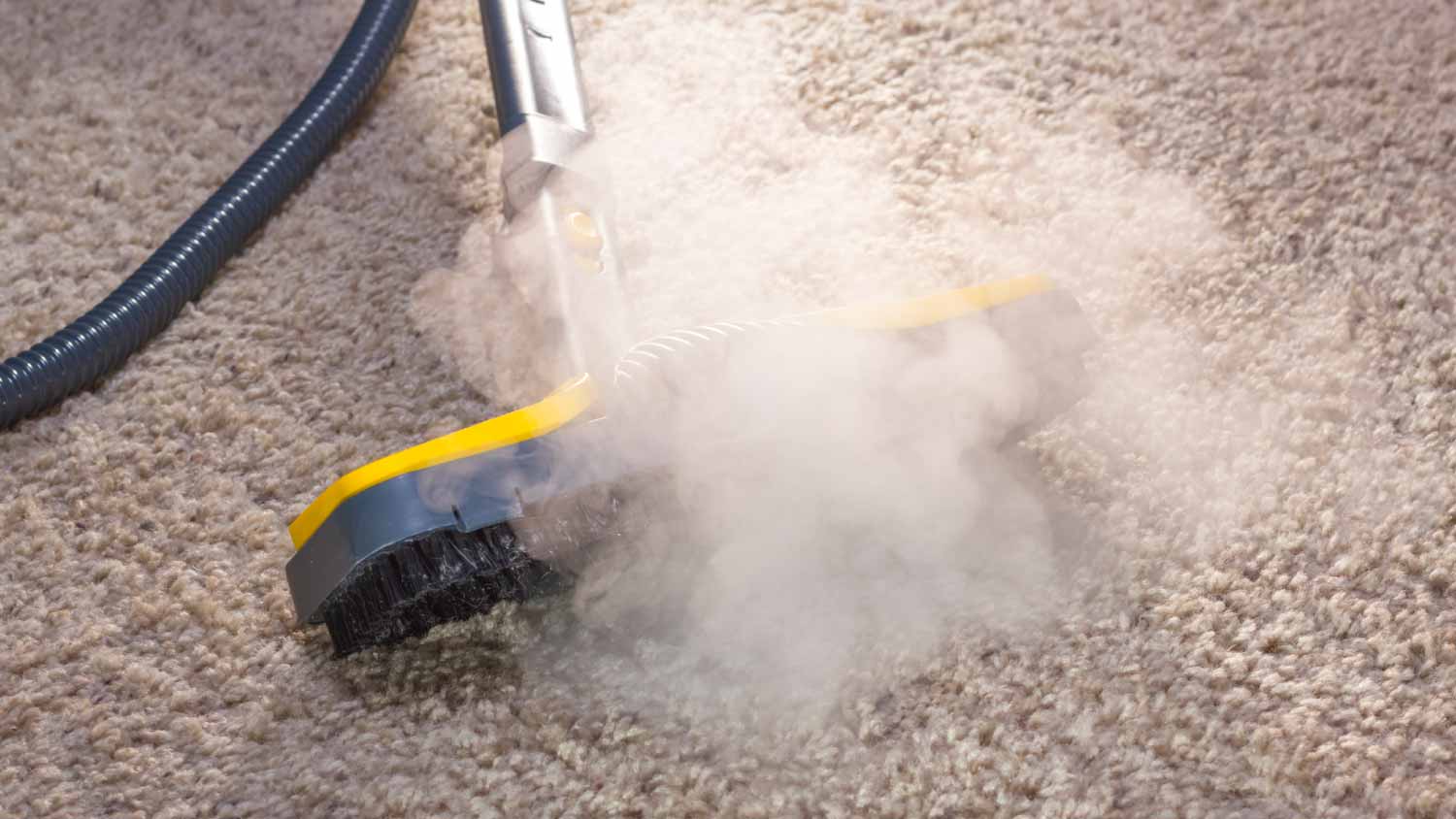
Planning ahead helps ensure an efficient, budget-friendly move. Learn how much move-out cleaning services cost based on factors like home type and size.
Just add water and feel the clean


Nothing feels better than a day at the spa with a nice steam to clear your pores and help you relax. The same could be said about your home—a good steam cleaning can make it feel fresh and rejuvenated. Steam cleaning your home is an amazing way to use fewer chemicals and tackle tough stains using only heat and water. If you just got a steam cleaner and are stuck on where to use it, we’ll break down the areas in your home you can clean with a steam cleaner.


The most popular use for a steam cleaner is your floors. It’s way more efficient than a mop or broom, and steam can remove the residue left by old cleaning products, leaving your floors feeling cleaner. It’s especially good at getting into the grout—no need to get on your hands and knees with a toothbrush.
However, not all floors can handle the heat. Unsealed floors trap moisture, causing them to plump, warp, twist, and mold. Furthermore, vinyl floors and some hardwood will also bend and warp from the high heat and pressure created by the steam cleaner—causing permanent, hard-to-fix damage and may even void your warranty.
| Pros | Cons |
|---|---|
| Can tackle grout lines with ease | Can damage some floor materials |
| Easier to get a deeper clean than a mop and broom | Can warp unsealed floors |
Best for: Sealed floors and tile with dirty grout.

Couches are some of the most important and high-traffic furniture in your home. A few times a year, your old couch needs TLC beyond your weekly vacuuming. Steam cleaning can penetrate deep into upholstered furniture like couches and armchairs, giving them new life and helping them feel as good as new.
However, some upholstery, like velvet, velour, or anything containing plastic, can get damaged when exposed to high heat and excess water. Thankfully, your couch should have a fabric care label with a code based on government regulations; double-check before you steam your couch. Steaming your furniture also leaves behind a lot of moisture, so thoroughly dry each piece before putting it back together to eliminate the risk of mildew or mold building up.
| Pros | Cons |
|---|---|
| Can eliminate unwanted odors | Not recommended for certain fabrics |
| Penetrates deep into the fibers past what a vacuum can do | Long drying time |
Best for: Fabrics that can handle the heat.

After years of crafting culinary delights for you and your loved ones, your kitchen appliances might seem a little worse for wear. Your steam cleaner can loosen and break apart that caked-on grime built up from years of use and can tackle those hard-to-reach spots on your oven racks. Your stovetop is also a prime spot for a steam cleaner, getting into the crevices you cannot otherwise reach. If you’re burnt out on deep cleaning your kitchen and want to cook in a cleaner space, a steam cleaner is the perfect sous-chef.
You only need to worry about the electronics in your appliances. If not managed correctly, the steam can find itself in the electrical components of your appliances and cause damage. It’s best to work in short, concentrated bursts to avoid letting the steam work up to where any circuit boards are.
| Pros | Cons |
|---|---|
| Loosens caked-on grime | Can cause damage to electrical components |
| Versatile clean | Requires some effort to get all crevices |
Best for: Ovens and stove tops.

Mirrors and windows are notoriously difficult to keep clean, and the wrong products could result in streaks and lines. A steam cleaner can help you tackle a dirty mirror or window so you can start seeing yourself and the world anew.
For windows, you want to be particularly careful, as the tempered glass can crack due to the drastic temperature change created by your steam cleaner. To avoid this, gradually introduce the steam onto the window before cranking it up to where you need it, and only use it sparingly.
| Pros | Cons |
|---|---|
| Doesn’t leave streak marks | Can damage glass on windows if not done properly |
| No need for toxic chemicals | Slower approach required |
Best for: All mirrors and gradual introduction on windows.

You don’t want to step on dirty carpets all day, and steam cleaning them can help you feel better about putting your best foot forward. The steam will get into the fibers to remove built-up dirt and bacteria and eliminate any old odors. Before steam cleaning, vacuum and spot-treat any particularly stained areas to maximize your carpet cleaning. Ensure your carpet is thoroughly dry to prevent mold or mildew from forming.
Pro tip: Use a folded microfiber cloth around the areas you’re steaming to help catch any dirt splatter that may pop up as you go, leaving less work to get your carpets spotless.
| Pros | Cons |
|---|---|
| Penetrates carpet fibers more effectively than a vacuum | Long drying time |
| Easier to maneuver than a mop | Can set stains if not careful |
Best for: Sporadic cleaning in conjunction with regular vacuuming and spot cleaning.
You can now sleep better at night knowing you’ve found a better way to keep your bedding clean and dirt-free. Whether you need a mattress refresh or your pillows are looking a little worse for wear, a steam cleaner can help make for a cleaner sleep. Steaming can also be very effective at keeping out bed bugs, getting rid of bacteria, and preventing infestations.
However, your bedding is very absorbent, and the excess water, if not applied properly, could leave damage or cause mold and mildew to appear. Make sure that you thoroughly dry items before remaking your bed.
| Pros | Cons |
|---|---|
| Can deter and treat bed bugs | Long drying times |
| Eliminates bacteria | Excess water can damage absorbent items |
Best for: Heavily soiled or infested bedding.
Backyard chefs rejoice: Your steam cleaner is one of the best tools for blasting away years of charred food, sticky marinades, and carbonized build-up from your grill without harsh degreasers. Steam penetrates the tough-to-reach areas like grates, drip trays, and burner covers, breaking down all the stubborn residue that you don’t want on your kabobs.
Before you begin, make sure the grill is completely cool and disconnected from any gas source. Remove the grates and trays for separate steaming, and avoid aiming steam at ignition switches or control knobs to prevent electrical damage or corrosion.
| Pros | Cons |
|---|---|
| Loosens cooked-on grime with light scrubbing | Can damage electrical components if steam reaches igniters |
| Great for both gas and charcoal grills | Requires disassembly for deep cleaning |
Best for: Grill grates, heat shields, and drip pans on gas or charcoal BBQs
A steam cleaner is an excellent tool for loosening the dirt, dust, and grime that accumulate on your patio furniture. Steam can revive plastic, metal, or treated wood furniture without the heavy scrubbing or harsh chemicals. It can also be used on outdoor cushions, provided the fabric is steam-safe and dried thoroughly.
Be cautious when using a steam cleaner on wood that hasn’t been treated or fragile materials, as the moisture and heat can cause swelling or warping. Always check the care tags on fabric and test a small area before going full steam ahead.
| Pros | Cons |
|---|---|
| Removes built-up grime without scrubbing | Can damage untreated wood or delicate fabrics |
| Eco-friendly alternative to chemicals | Outdoor cushions require thorough drying to avoid mildew |
Best for: Plastic chairs, metal frames, outdoor tables, and washable cushions.
Your backsplash and tile walls around sinks and stoves can get coated with grease, food splatters, and soap residue. Steam cleaning breaks it up quickly, especially in difficult-to-clean grout lines.
When steam cleaning tiles, avoid prolonged steam exposure to decorative tiles with adhesive or paint overlays.
| Pros | Cons |
|---|---|
| Loosens cooked-on grime with little scrubbing | Can damage electrical components if steam reaches igniters |
| Great for both gas and charcoal grills | Requires disassembly for deep cleaning |
Best for: Kitchen and bathroom tile.
Hard plastic toys are perfect candidates for steam cleaning, especially if you’re trying to avoid using chemical disinfectants. A blast of steam can sanitize toys after a playdate or illness without using anything toxic.
Avoid battery-powered toys or anything with open seams where moisture could enter.
| Pros | Cons |
|---|---|
| Nontoxic sanitizing | Can damage electronics |
| Great for baby toys or teething items | May leave toys too hot to touch immediately |
Best for: Solid plastic toys and blocks.
Your steam cleaner isn’t just for the house; you can use it in your car, too. It’s especially useful for fabric seats, door panels, cupholders, and carpeted floors.
Don’t use a steam cleaner on leather unless it has an attachment specifically rated safe for leather.
| Pros | Cons |
|---|---|
| Great for tight spaces and crevices | Not safe for leather or sensitive electronics |
| Removes food spills and pet hair buildup | May fog windows or dashboards if overused |
Best for: Cloth upholstery and carpets.
Your pet’s bed and crate can harbor odors, dirt, and bacteria, even after a wash. A steam cleaner can help sanitize soft surfaces and neutralize smells while being safer than chemical cleaners.
Avoid steaming foam inserts directly as they can trap moisture and grow mold.
| Pros | Cons |
|---|---|
| Helps extend the life of pet bedding between washes | Can damage foam or memory foam if over-saturated |
| Removes odors and bacteria without harsh chemicals | Requires full drying to avoid mildew or odor |
Best for: Crates, washable pet beds, and hard plastic carriers.
Soap scum, mildew, and grime build up quickly in bathrooms, especially around the tub and shower. Steam cleaning can help lift stains and kill bacteria without using harsh bleach or scrubbing on your hands and knees. Use it on tile walls, glass doors, and metal fixtures to loosen grime and buildup before wiping it away.
Avoid using steam directly on caulk, especially if it’s old or loose, as it can deteriorate with prolonged exposure.
| Pros | Cons |
|---|---|
| Removes soap scum and mildew | Can weaken old caulking |
| Sanitizes without harsh chemicals | Requires good ventilation to dry |
Best for: Tile, grout, and non-porous bathroom surfaces.
Even with liners, trash cans collect grime and odors over time. A steam cleaner can sanitize the inside and outside of indoor and outdoor cans, killing bacteria and helping neutralize smells without bleach.
| Pros | Cons |
|---|---|
| Helps eliminate lingering odors | Can splash and spread messes if not used carefully |
| Great for sticky residue | Requires thorough drying to prevent mildew |
Best for: Plastic and metal trash cans.
Window tracks and door rails are extremely tight crevices that are dust and gunk magnets. Steam cleaning helps loosen and flush out the grime from window tracks and sliding door rails without the need for poking around with toothpicks or toothbrushes.
| Pros | Cons |
|---|---|
| Reaches into narrow, hard-to-clean areas | Can blow loosened debris around |
| Dissolves sticky dirt buildup | May cause rust in older aluminum tracks if not dried |
Best for: Window tracks, shower door runners, and sliding door rails.
High-touch areas like light switches and door handles can harbor tons of germs. A steam cleaner can sanitize these spots quickly without any chemicals, and it’s especially handy to have during cold and flu season.
| Pros | Cons |
|---|---|
| Chemical-free germ removal | Excess moisture may seep behind switch plates |
| Quick, contactless sanitizing | Not suitable for delicate finishes or older electrical fixtures |
Best for: Plastic switch plates, metal doorknobs, and drawer pulls.
Considering the slightest trace of chemical residue can wipe out a tank’s livestock and destroy its delicate ecosystem, a steam cleaner is an invaluable tool for aquarium keepers. Steam cleaning provides a safe, chemical-free way to sanitize essentials like nets, siphon tubes, algae scrapers, and scrub brushes between uses or when switching between tanks. It also effectively eliminates harmful bacteria, algae, parasites, and pest microfauna, helping protect your fish and plants without introducing toxins.
Never use a steam cleaner directly on a filled tank or any heat-sensitive plastic components. Ensure all items are fully cooled and dry before placing them back in the tank to avoid sudden water temperature fluctuations.
| Pros | Cons |
|---|---|
| Chemical-free sterilization | Can warp plastic if overheated |
| Helps prevent disease and pest transfer between tanks | Equipment must be cooled and dried thoroughly |
Best for: Nets, gravel vacuums, tank-safe brushes, and decor outside the aquarium.
A steam cleaner offers a chemical-free way to sanitize your gym equipment and accessories, such as yoga mats, benches, and dumbbells, killing bacteria and breaking down oils and buildup. Steam is especially handy for textured grips or fabric-covered gear that’s hard to wipe down thoroughly.
Be cautious with electronic components on machines like treadmills, bikes, or rowers. Avoid steaming screens, control panels, or wires, and always check the manufacturer’s guidelines before use.
| Pros | Cons |
|---|---|
| Reaches into textured and hard-to-clean surfaces | Can damage electronics or control panels |
| Deodorizes fabric-covered gear | May not be safe for some foam or rubber materials |
Best for: Yoga mats, benches, dumbbells, resistance bands, and other non-electronic gear.
Steam cleaning can remove caked-on sap, dirt, and bacteria, helping to keep gardening blades sharp and prevent plant diseases from spreading. It’s especially handy for sanitizing pruning tools like loppers or shears, as these can easily spread diseases to plants and trees when making a cut.
| Pros | Cons |
|---|---|
| Great for caked-on dirt and sap | Not ideal for wooden handles |
| Sanitizes without harsh cleaners | Tools must be dried immediately to prevent rust |
Best for: Metal garden tools like pruners, shovels, and shears.
Air vents and registers collect a ton of dust, allergens, and pet hair, which can recirculate through your home and affect the indoor air quality. A steam cleaner is a powerful tool for blasting away the build-up without chemical sprays. It can help loosen gunk stuck between vent slats and sanitize metal or plastic covers, especially in kitchens or bathrooms where grease and moisture tend to accumulate.
Be sure to turn off your HVAC system before cleaning, and avoid directing steam into the ductwork itself, which could introduce excess moisture and encourage mold growth.
| Pros | Cons |
|---|---|
| Loosens and removes dust and grime | Not safe for use directly inside ducts |
| Helps improve air quality | May warp or rust uncoated metal if oversteamed |
Best for: Removable vent covers, bathroom exhaust fans, and floor registers.
Looking at all the ways a steam cleaner can benefit your life, it’s easy to believe that these machines can solve all your cleaning problems. But due to their high pressure and temperatures, a steam cleaner can potentially cause damage to certain areas of your home, including:
Unsealed floors or flooring with cracks
Cheap laminate flooring or countertops
Certain fabric couches like velvet, velour, or anything containing plastic
Walls with wallpaper or water-based paint
Silks
Anything porous
Untempered glass
Before going wild with your steam cleaner, check the laundry or care instructions on any furniture or items you’re looking to steam clean before you start to save yourself the trouble.
From average costs to expert advice, get all the answers you need to get your job done.

Planning ahead helps ensure an efficient, budget-friendly move. Learn how much move-out cleaning services cost based on factors like home type and size.

Hiring a house cleaner frees up your schedule and keeps your home spotless. The cost to hire a house cleaner depends on the size of your house, your schedule, and who you hire. Use this guide to understand typical house cleaning prices better.

Hiring a house cleaner frees up your schedule and keeps your home spotless. The cost to hire a house cleaner depends on the size of your house, your schedule, and who you hire. Use this guide to understand typical house cleaning prices better.

Hiring a house cleaner can save you time while making it easier to keep up with your home chores. Find out how much to tip house a cleaner for a job well done.

If you’ve just installed new tiles only to find them covered in a dull film a few days later, don’t panic. We’ll show you how to remove grout haze promptly and effectively.

If your kitchen pantry is a mess, here’s how to hire a professional pantry organizer to cut through the clutter.